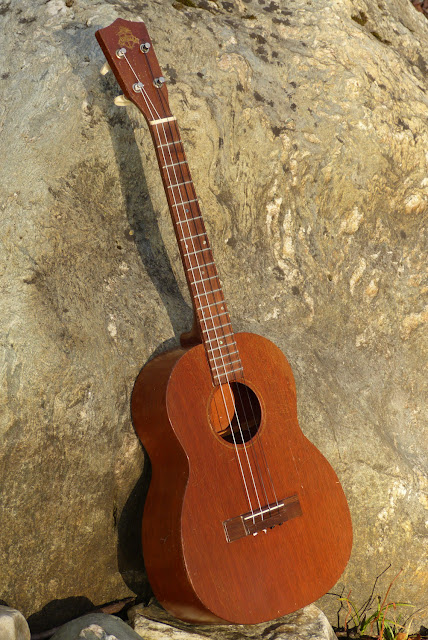1950s Favilla Baritone Ukulele
A customer who I share the curse of buy-too-much with dropped this off for consignment as, I think, he has a couple more of these at home. Regular readers will know by now how much I like these New York-made Favilla baritone ukes -- I (personally) prefer them to Martins or Gibsons and they're on equal footing, in my eyes, with vintage Kamakas. They have an airy, warm, flamenco sort of sound that runs a little drier than a Martin but, to me, responds more on a dime.
I did the usual work on this one -- a fret level/dress, light saddle-area shave and saddle shave, and a full setup. At the same time I also repaired a loose seam and small hairline crack on the lower-bout back. Overall, however, this is a very clean baritone and it sounds delicious. Playability is on-the-dot with 1/16" action at the 12th fret. I have it strung with GHS "100s" -- their black-nylon, standard bari set. I think they sound good (I use them when stringing-up as they're neutral) but I would love to hear it with slightly-heavier trebles that can really be dug-into.
The body is solid mahogany and lightly ladder-braced.
There are no cracks except for the one mentioned on the back, though there's a run-line in the finish to the treble side of the bridge that looks like a hairline crack but isn't.
The bone nut is original and the tuners are, too, though I replaced the ferrules with a matching vintage set so it wouldn't have a mismatched set of them.
The fretboard is Brazilian rosewood and, I think, the dots may have been replaced with abalone as I seem to recall these having either faux-pearl dots or white pearl dots usually. I may be going a bit nutty, though. This bari is on the earlier side -- probably an early-50s model.
The neck has a medium C-shaped profile and feels great (though you can tell in the soundclip I get a bit confused here and there as I'd just been playing a guitar).
Note all the weather-check to the finish. It's all over the instrument and this is really typical of Favilla finish jobs. It's a thin, nitro finish and that's par for the course.
I string these "uke style" with balled-up (a few granny knots thrown into one another) ends which yields better down-pressure on the (bone) saddle.




















Comments